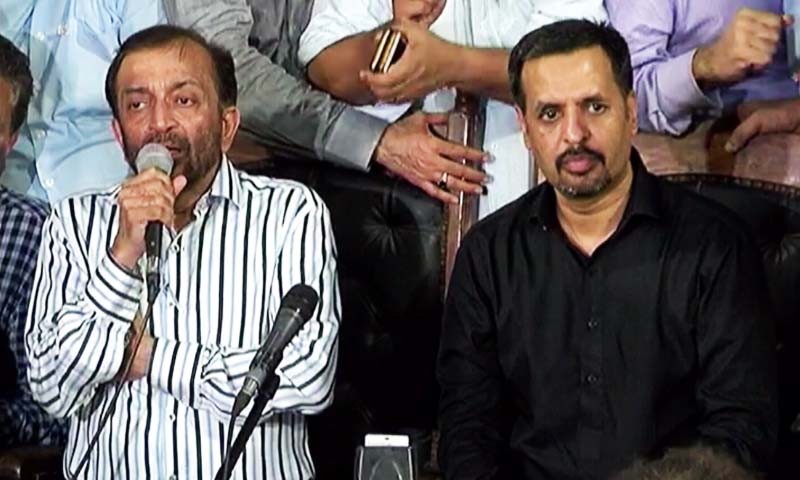
How easy is it to manipulate elections? The case of MQM and PML-N

Political engineering, an expression that describes manipulation of political events and parties by the military establishment, can be traced back to the Aug 2016 Karachi. Back then, a situation was engineered to oust the Muttahida Qaumi Movement (MQM) leader Altaf Hussain from the political scene, loosen the grip of the MQM’s militant wing on the city’s political and civic life and shatter the image of the MQM as a supreme electoral force in the country’s biggest city.
The establishment used tools of coercive state power to subdue the MQM leadership; the party’s top leaders were arrested, its offices in different localities of the city were bulldozed, and its cadre was chased and arrested.
The result was a divided MQM. Three groups -- Pak-Sarzameen Party, MQM-Pakistan and MQM-London emerged out of the original MQM. Yet, the appeal of Altaf Hussain didn’t wane for political analysts ascribe low turnout in Karachi in last month’s general election to Hussain’s appeal for boycott.
The establishment’s role in Karachi’s politics and the divisions in MQM became visible in the August 22, 2016 speech of Altaf Hussain that led to a massive crackdown on the MQM’s top leadership and its cadre. Political analyst Zaigham Khan says that the establishment’s tilt towards the Pak Sarzameen Party was visible from the day Altaf Hussain delivered his speech. "The Aug 22 speech by Altaf Hussain divided the party. Later, the party came under pressure from the establishment and manipulations took place."
"Arrests on massive scale and bulldozing of MQM offices all across Karachi dealt a blow to the organisational structure of the party", says Zaigham Khan.
On Aug 22, 2016, Hussain made anti-state remarks in a speech delivered over phone from London, following which the establishment acted against his party with full force. Former Attorney General, Irfan Qadir says, the state went into "overkill". He tells TNS that there are laws in Pakistan Penal Code and Pakistan Army Act which can be applied in such situations. "There are laws in statute books to deal with such occurrences, but are not applied if they could lead to more problems," he says, adding, "Going after the whole political party should not have been the state response".
Karachi witnessed chaos when the government machinery, with approval from the then prime minister Nawaz Sharif, went out to demonise the political party.
Surely there was a method in the madness. The MQM’s top leadership and cadre were arrested in Karachi and Hyderabad. The local municipal authorities bulldozed its offices constructed on government land, and removed all signs of its presence in the city. Only those that decided to part ways with the MQM-London were not harassed by the state machinery. Altaf Hussain was accused of being a RAW (Research and Analysis Wing, India) agent. And, not surprisingly, the man who came out with supposedly 100 per cent accurate evidence to implicate the MQM leader was none other than the establishment’s new ‘boy’, Mustafa Kamal.
Who knew that Nawaz Sharif, the then prime minister, who partook in the 2016 political engineering will face a similar wrath of the establishment. Both the Pakistan Muslim League- Nawaz (PML-N) and MQM were dubbed as anti-establishment parties, working on the dictates of Indian masters and friends.
When Supreme Court announced the verdict to oust Nawaz Sharif from power, a whole bunch of social media activists, with dubious links, came after him and maligned him as one working against the country’s national interest on the dictates of RAW. Interestingly, the story making the rounds on social media in those days was that Pakistani intelligence services had arrested two RAW agents from Sharif’s sugar mill.
"The portrayal of Nawaz Sharif and PML-N as a party which cannot win pushed the 12 per cent undecided voters away from it. This is pre-poll rigging," says Zaigham Khan.
Also, Nawaz Sharif’s PML-N was accused of betraying the Khatm-i-Nabuwwat (the Finality of Prophethood) issue which eventually cost the party 14 seats in Central Punjab. According to Muhammad Amir Rana, an expert on counterterrorism and extremism, "PML-N lost 14 National Assembly seats in Central Punjab because of Tehreek-i-Labbaik Pakistan. This religious propaganda that continued for more than a year, and was most intense in and around the urban centres in Central Punjab, portrayed the PML-N as a party destined to lose.
Political observers are clear that all this was part of systematic manipulation by intelligence services to keep Nawaz Sharif and his party away from power. "Both the accusations of involvement with RAW and the issue of Khatm-i-Nabuwat seemed parts of systematic manipulation carried out to hurt Nawaz Sharif and his party," says Ahmed Bilal Mehboob, President PILDAT. "There is no empirical evidence, but suspicion and circumstantial evidence points towards the state’s security agencies instigating this chaos."
The party’s winning spree in the by-elections, particularly in Lodhran, was curtailed by design. A deal was forged between the Pakistan People’s Party (PPP) and Pakistan Tehreek-i-Insaf (PTI) leaders to dislodge PML-N’s Balochistan chief minister and replace him with an independent candidate.
Political engineering does follow a pattern though -- of adding fuel to the fire. Take the case of differences between the London based and Karachi based MQM leadership. The differences had already existed. The establishment simply exploited them. Likewise, by removing the PML-N chief minister in Balochistan, the establishment instigated a revolt within the party in the Balochistan provincial assembly. But, according to local analysts, the MPAs were already unhappy with the central PML-N leaders.